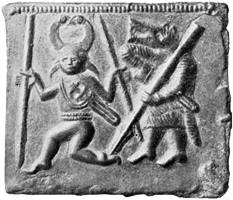
This page created 25 May 2014, and last modified: 26 October 2014 (Frankfurt fragment image added)

In the western half of the empire, the fourth-most senior auxilia palatina unit listed in the Magister Peditum's infantry roster is the Celtae seniores; it is assigned to his Italian command. Its shield pattern is shown in various manuscripts as below, under the label Celtae in O, B, and Celte in P (which habitually omits the a in -ae word endings), and Ff:

The pattern shows a red ground featuring a yellow version of the twin-headed zoomorphic motif that is extremely common in the Notitia (over a dozen examples), especially amongst auxilia palatina: the version borne by the Celtae seniores has a fringed neck, and thus looks very similar to those borne by the Exculcatores iuniores Britanniciani, and in the eastern half of the empire, the Falchovarii, under the Magister Militum Praesentalis II.
In addition to its numerous appearances in the Notitia, the twin-headed zoomorphic motif is known from a range of sources in northern Europe, such as on the ca. 6th century Torslunda bronze die from Sweden shown below:

In the history of Ammianus, "the" Celtae are found brigaded with the Petulantes (20.4.2, 20.4.20, 20.5.9, 21.3.2, 22.12.6, 31.10.4). In the Notitia, the Celtae seniores are indeed immediately preceded by the Petulantes seniores; whereas the Celtae iuniores is listed under the command of the Comes Africae, and does not appear to have any obvious partner (the Petulantes iuniores is listed under the Magister Militum per Illyricum; its pattern neither resembles that of the Celtae iuniores, nor those of the two seniores units), and so it would appear that "the" Petulantes and Celtae in Ammianus correspond to the Notitia's Petulantes seniores and Celtae seniores.
The name Celtae is tribal, referring to "the" Celts. When the unit was split between seniores and iuniores is unknown, other than being mid-4th century.

Return to the Notitia alphabetical unit list page.
Return to my Notitia index page.